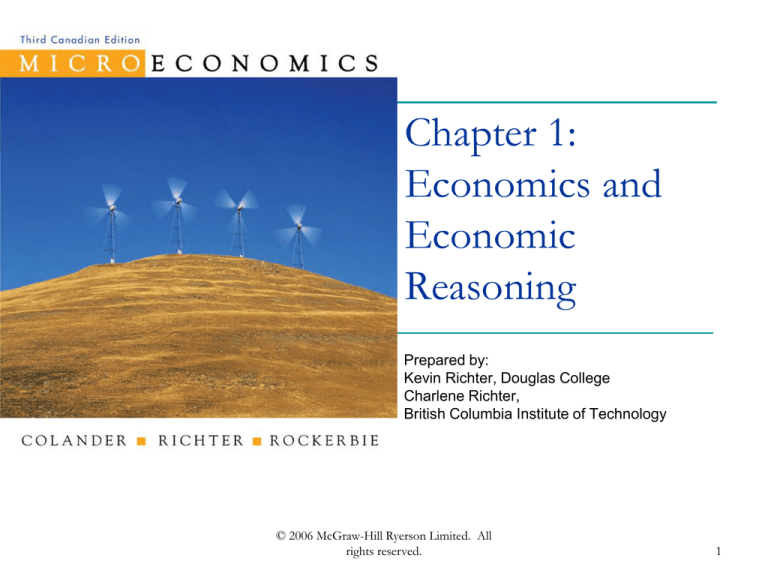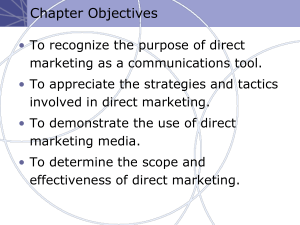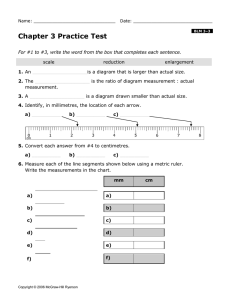
Chapter 1:
Economics and
Economic
Reasoning
Prepared by:
Kevin Richter, Douglas College
Charlene Richter,
British Columbia Institute of Technology
© 2006 McGraw-Hill Ryerson Limited. All
rights reserved.
1
What Economics Is
Economics is the study of how individuals,
firms, and governments make optimal
choices from among a set of alternatives
when facing scarce resources.
© 2006 McGraw-Hill Ryerson Limited. All
rights reserved.
2
What Economics Is
Key words:
choice
alternative
scarcity
© 2006 McGraw-Hill Ryerson Limited. All
rights reserved.
3
What Economics Is
Scarcity exists because individuals want
more than available resources can produce.
Wants are unlimited, but resources are
limited.
© 2006 McGraw-Hill Ryerson Limited. All
rights reserved.
4
What Economics Is
The degree of scarcity is constantly changing.
The quantity of goods, services, and usable
resources depends on technology and human
action.
© 2006 McGraw-Hill Ryerson Limited. All
rights reserved.
5
What Economics Is
Any economic system must solve three
central coordination problems:
What, and how much, to produce.
How to produce it.
For whom to produce it.
© 2006 McGraw-Hill Ryerson Limited. All
rights reserved.
6
What Economics Is
In this course you will learn:
Economic reasoning.
Economic terminology.
Economic insights economists have about issues,
and theories that lead to those insights.
© 2006 McGraw-Hill Ryerson Limited. All
rights reserved.
7
What Economics Is
To understand the economy, you need to
learn:
Information about economic institutions.
Information about the economic policy options
facing society today.
© 2006 McGraw-Hill Ryerson Limited. All
rights reserved.
8
A Guide to Economic Reasoning
Economic reasoning is making decisions by
comparing costs and benefits.
© 2006 McGraw-Hill Ryerson Limited. All
rights reserved.
9
Marginal Costs and Marginal Benefits
The relevant costs and benefits are the
expected incremental, or additional, costs
incurred and the expected incremental
benefits of a decision.
© 2006 McGraw-Hill Ryerson Limited. All
rights reserved.
10
Marginal Costs and Marginal Benefits
Economist use the term marginal when
referring to additional or incremental.
© 2006 McGraw-Hill Ryerson Limited. All
rights reserved.
11
Marginal Costs and Marginal Benefits
Marginal cost – the additional cost to you
over and above the costs you have already
incurred.
This means not counting sunk costs – costs
that have already been incurred and cannot
be recovered.
© 2006 McGraw-Hill Ryerson Limited. All
rights reserved.
12
Marginal Costs and Marginal Benefits
Marginal benefit – the additional benefit
above and beyond what you’ve already
accrued.
© 2006 McGraw-Hill Ryerson Limited. All
rights reserved.
13
Marginal Costs and Marginal Benefits
According to the economics decision rule:
If the relevant benefits of doing something exceed
the relevant costs, do it.
If the relevant costs of doing something exceed
the relevant benefits, don’t do it.
© 2006 McGraw-Hill Ryerson Limited. All
rights reserved.
14
Economics and Passion
Economic reasoning is based on the premise
that everything has a cost.
It leads to a better society for the majority of
people.
© 2006 McGraw-Hill Ryerson Limited. All
rights reserved.
15
Opportunity Cost
The Opportunity cost of the chosen activity
is the value of the next-best alternative to the
activity you have chosen.
Opportunity cost is the basis of cost/benefit
economic reasoning.
© 2006 McGraw-Hill Ryerson Limited. All
rights reserved.
16
Opportunity Cost
In economic reasoning, opportunity cost must
be less than the benefit of what you have
chosen.
© 2006 McGraw-Hill Ryerson Limited. All
rights reserved.
17
Economic and Market Forces
The opportunity cost concept applies to all
aspects of life.
It is fundamental to understanding how
society reacts to scarcity.
© 2006 McGraw-Hill Ryerson Limited. All
rights reserved.
18
Economic and Market Forces
When goods are scarce, they must be
rationed.
Rationing is the mechanism for determining
who gets what.
© 2006 McGraw-Hill Ryerson Limited. All
rights reserved.
19
Economic and Market Forces
Economic reality is controlled by three forces:
Economic forces (the invisible hand).
Social and cultural forces.
Political and legal forces.
© 2006 McGraw-Hill Ryerson Limited. All
rights reserved.
20
Economic and Market Forces
Economic forces are the necessary
reactions to scarcity.
A market force is an economic force that is
given relatively free rein by society to work
through the market.
© 2006 McGraw-Hill Ryerson Limited. All
rights reserved.
21
Economic and Market Forces
Market forces ration quantity by changing
prices.
When there is a shortage, the price goes up.
When there is a surplus, the price goes
down.
© 2006 McGraw-Hill Ryerson Limited. All
rights reserved.
22
Economic and Market Forces
The invisible hand is the price mechanism -the rise and fall of prices -- that guides our
actions in a market.
© 2006 McGraw-Hill Ryerson Limited. All
rights reserved.
23
Economic and Market Forces
Political and social forces often work together
against the invisible hand.
What happens in society can be seen as a
reaction to, and interaction of, the invisible
hand, political and legal forces, and social
and cultural forces.
© 2006 McGraw-Hill Ryerson Limited. All
rights reserved.
24
Theories, Models and Assumptions
General insights into how economies work
are often based on generalizations called
economic theories.
© 2006 McGraw-Hill Ryerson Limited. All
rights reserved.
25
Theories, Models and Assumptions
Economic theories are abstract.
A theory is often embodied in an economic
model or an economic principle.
© 2006 McGraw-Hill Ryerson Limited. All
rights reserved.
26
Theories, Models and Assumptions
Economic model – a set of simple
behavioural assumptions to explain decision
making.
© 2006 McGraw-Hill Ryerson Limited. All
rights reserved.
27
Theories, Models and Assumptions
Economic principle – a commonly held
insight stated as a law or general
assumption.
© 2006 McGraw-Hill Ryerson Limited. All
rights reserved.
28
Theories, Models and Assumptions
Economists cannot test their models with
controlled experiments.
It is impossible to hold “other things
constant,” as is done in laboratory
experiments.
© 2006 McGraw-Hill Ryerson Limited. All
rights reserved.
29
Theories, Models and Assumptions
Theories, models, and principles must be
combined with a knowledge of real-world
economic institutions to arrive at a specific
policy recommendation.
In order to understand the theory you must
understand the assumptions underlying the
theory.
© 2006 McGraw-Hill Ryerson Limited. All
rights reserved.
30
The Invisible Hand Theory
Economist have observed:
Price tends to fall when the quantity supplied is
greater than the quantity demanded.
Price tends rise when the quantity demanded is
greater than the quantity supplied.
© 2006 McGraw-Hill Ryerson Limited. All
rights reserved.
31
The Invisible Hand Theory
According to the invisible hand theory, a
market economy, through the price
mechanism, will allocate resources efficiently.
Efficiency means achieving a goal as
cheaply as possible.
© 2006 McGraw-Hill Ryerson Limited. All
rights reserved.
32
Economic Theory and Stories
Economic theory and its models are a
shorthand means of telling a story.
If you can’t translate a theory into a story, you
don’t understand the theory.
© 2006 McGraw-Hill Ryerson Limited. All
rights reserved.
33
Microeconomics and Macroeconomics
Economics is divided into two parts:
microeconomics and macroeconomics.
© 2006 McGraw-Hill Ryerson Limited. All
rights reserved.
34
Microeconomics
Microeconomics is the study of individual
decision making.
It considers household and business
decisions, market allocations and pricing
policies.
© 2006 McGraw-Hill Ryerson Limited. All
rights reserved.
35
Macroeconomics
Macroeconomics is the study of the
economy as a whole.
It considers the problems of inflation,
unemployment, business cycles, and
economic growth.
© 2006 McGraw-Hill Ryerson Limited. All
rights reserved.
36
Economic Institutions
In applying economic theory to reality, you
must know about economic institutions.
Economic institutions are the laws,
common practices, and social, political, and
religious organization, of a society.
© 2006 McGraw-Hill Ryerson Limited. All
rights reserved.
37
Economic Institutions
Economic institutions differ significantly
among nations.
They sometimes seem to operate in ways
quite different than economic theory predicts.
© 2006 McGraw-Hill Ryerson Limited. All
rights reserved.
38
Economic Policy Options
Economic policies are actions taken by
government to influence economic events.
© 2006 McGraw-Hill Ryerson Limited. All
rights reserved.
39
Economic Policy Options
To carry out economic policy effectively, one
must understand how the economic policy
might change institutions.
© 2006 McGraw-Hill Ryerson Limited. All
rights reserved.
40
Objective Policy Analysis
Objective policy analysis keeps the value
judgments separate from the analysis.
Subjective policy analysis is that which
reflects the analyst’s view of how things
should be.
© 2006 McGraw-Hill Ryerson Limited. All
rights reserved.
41
Objective Policy Analysis
To make clear the distinction between
objective and subjective analysis, economics
is divided into three categories:
Positive economics
Normative economics
Science of economics
© 2006 McGraw-Hill Ryerson Limited. All
rights reserved.
42
Objective Policy Analysis
Positive economics – the study of what is,
and how the economy works.
Normative economics – the study of what
the goals of the economy should be.
© 2006 McGraw-Hill Ryerson Limited. All
rights reserved.
43
Objective Policy Analysis
Science of economics – the application of
the knowledge learned in positive economics
to achieve the goals determined in normative
economics.
© 2006 McGraw-Hill Ryerson Limited. All
rights reserved.
44
Objective Policy Analysis
It is hard to maintain objectivity in the science
of economics.
It embodies the problems of both positive and
normative economics
© 2006 McGraw-Hill Ryerson Limited. All
rights reserved.
45
Policy and Social and Political Forces
The choice of policy options depends on
more than economic theory.
Political and social forces must be taken into
account when applying economic theory to
policy.
© 2006 McGraw-Hill Ryerson Limited. All
rights reserved.
46
Economics and Economic
Reasoning
End of Chapter 1
© 2006 McGraw-Hill Ryerson Limited. All
rights reserved.
47
The Language of Graphs
Chapter 1 Appendix
© 2006 McGraw-Hill Ryerson Limited. All
rights reserved.
48
Horizontal Number Line
A
-3
-2
-1
0
1
2
© 2006 McGraw-Hill Ryerson Limited. All
rights reserved.
3
4
5
49
Vertical Number Line
40
30
20
10
0
B
- 10
- 20
- 30
- 40
© 2006 McGraw-Hill Ryerson Limited. All
rights reserved.
50
Coordinate System
40
30
20
10
0
B
(1, 20)
A
1
2
3
© 2006 McGraw-Hill Ryerson Limited. All
rights reserved.
4
(4, 5)
5
51
From Table to Graph
A
B
C
D
E
Price of Qty of Pens
Pens
Bought per
(in dollars)
Day
$3.00
4
2.50
5
2.00
6
1.50
7
1.00
8
$3.00
Price of pens (in dollars)
Price Quantity Table
2.50
2.00
1.50
A
B
C
D
E
1.00
.50
0
© 2006 McGraw-Hill Ryerson Limited. All
rights reserved.
1 2 3 4 5 6 7 8
Quantity of pens bought
52
Price (in dollars)
Nonlinear Curve
$6
5
4
3
2
1
0
10
20
Quantity
© 2006 McGraw-Hill Ryerson Limited. All
rights reserved.
30
40
53
Slopes of Curves
c
10
9
8
7
Slope = 1
d
Rise = 1
Run = 1
A
Slope = 4
Slope = -4
6
Rise = 4
Rise = -4
5
B
4
2
Run = 1
Slope = -0.5
3
Run = 2
L
Slope = 1
b
e
0
1
2
e
a
Rise = -1
1
Run = 1
3
4
5
6
L
7
© 2006 McGraw-Hill Ryerson Limited. All
rights reserved.
8
9
E
Rise =1
Run = 1
10
11
54
Inverse and Direct Relationships
Inverse relationship:
When X goes up, Y goes down
When X goes down, Y goes up
Direct relationship:
When X goes up, Y goes up
When X goes down, Y goes down
X
X
Y
© 2006 McGraw-Hill Ryerson Limited. All
rights reserved.
Y
55
Maximum Point
Maximum
Slope = 0
A
© 2006 McGraw-Hill Ryerson Limited. All
rights reserved.
56
Maximum and Minimum Points
B
Slope = 0
Minimum
© 2006 McGraw-Hill Ryerson Limited. All
rights reserved.
57
Presenting Information Visually
© 2006 McGraw-Hill Ryerson Limited. All
rights reserved.
58
$14,000
Income (in dollars)
Income (in dollars)
The Importance of Scales
13,000
12,000
11,000
16,000
14,000
12,000
10,000
10,000
1992
$18,000
1994
1996
(a) Income over time (1)
1992
1994
1996
(b) Income over time (2)
© 2006 McGraw-Hill Ryerson Limited. All
rights reserved.
59
The Language of Graphs
End of Chapter 1 Appendix
© 2006 McGraw-Hill Ryerson Limited. All
rights reserved.
60




